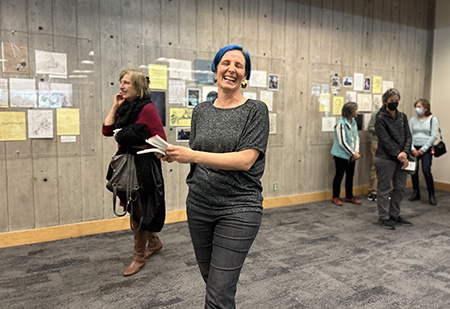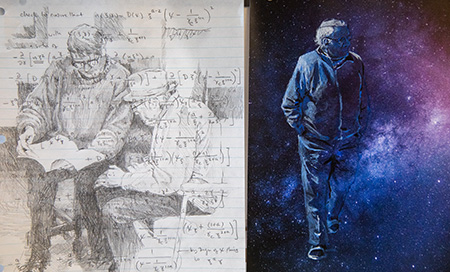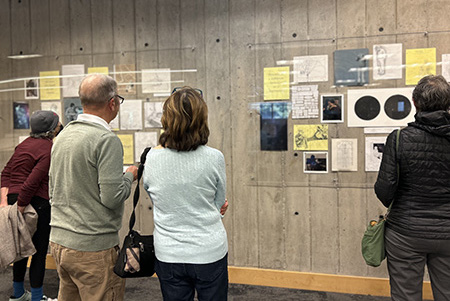Bill Mathews began working at UC Santa Cruz in 1970; 52 years later, he is remembered by his students, friends, and colleagues as a dedicated and dynamic astronomer and mentor. An inspiration and friend of many, Bill passed away in September 2021.
His daughter, Amey Mathews —an artist and yoga instructor—took ownership of thousands of pages of Bill’s old notes, covered in calculations and commentary. Amey began weaving portraits of her father into and over the notes, drawing out Bill’s presence on the pages.
The notes—typically dense calculations written on 8½-by-11-inch paper, galactic images, or even Post-its—gradually evolved into a most unique kind of canvas.
A curated selection of Amey’s work currently lives on the Sandra M. Faber Floor (third floor) of the Science and Engineering Library at UC Santa Cruz and is open to all. Amey says she is grateful to have this space dedicated to her father.
“I’m so thrilled to have this work here,” Amey said at a private reception for the exhibit. “I really love having it here at the library, I love having it here on campus, and I love having it in a place of contemplation and active thinking and learning.”
The exhibit is entitled “Big Questions: Astronomer Father/Artist Daughter” and will remain on display through Spring quarter.
“All of these are notes that my dad took not very many feet from here for 50-plus years,” Amey said at the Science and Engineering Library. “So it feels really meaningful to share him and his work in this context and in this place.”
Bill contributed fundamental knowledge to understanding some of the most energetic phenomena in the universe. He employed atomic physics and hydrodynamics to understand luminous interstellar gas clouds—glowing nebulae—that formed because of phenomena such as the remnants of dying stars in the galaxy and quasars expelling energetic gasses.
His early work focused on how dust forms in galactic gas clouds, and by the 1970s, his work had advanced our fundamental understanding of various types of glowing nebulae.
His legacy includes more than 200 publications in professional journals and conference proceedings. In addition to his work in the Astronomy and Astrophysics Department, Bill had a lifelong interest in music and taught a popular course at UCSC on the physics of music.
“He was an enthusiastic person about life, about science, and about his family—he just had a lot of enthusiasm,” Amey said. “I started coming out to my art space and sitting with all of these papers, my memory of him, my love for him, and his love of this subject—it was such a meaningful part of his life.”
Bill is also remembered by The Bill Mathews Fund for Excellence in Astronomy and Astrophysics which was established by Cynthia Mathews to support current graduate students and attract outstanding graduate student candidates to the department. Cynthia—former Santa Cruz mayor, long-term city council member, and Santa Cruz Planned Parenthood co-founder—was married to Bill for 57 years.
The fund supports graduate program fellowships, individual graduate student research programs, travel funds for graduate students to attend meetings and deliver talks, and participation in collaborations.
“It was clear he always wanted this to happen,” Cynthia said. “Bill’s career in astronomy and astrophysics was enormously rewarding to him. He was grateful to work in such a continually exciting field with wonderful colleagues; he wanted to invest in future generations of astronomers to carry on.”





